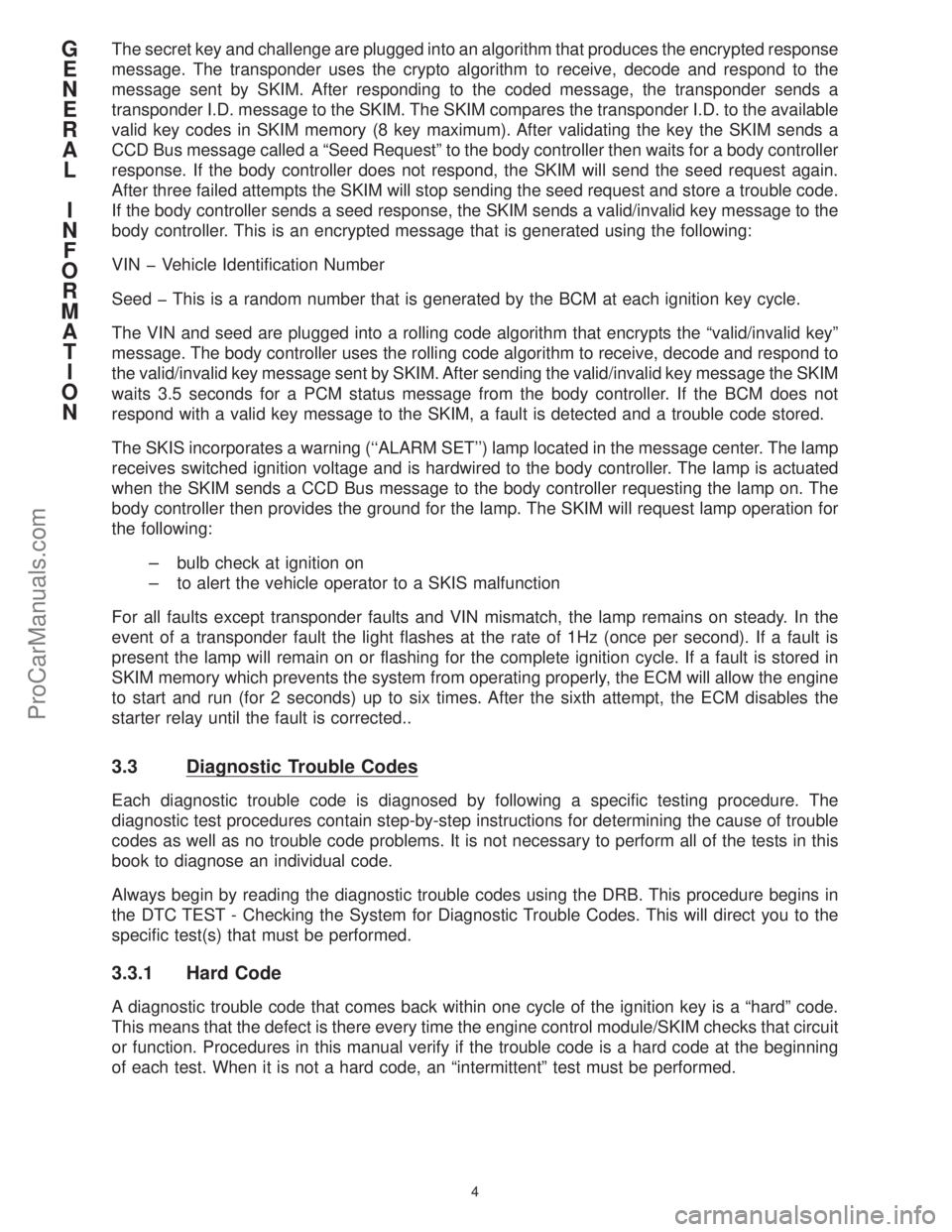warning CHRYSLER CARAVAN 2000 Service Manual
[x] Cancel search | Manufacturer: CHRYSLER, Model Year: 2000, Model line: CARAVAN, Model: CHRYSLER CARAVAN 2000Pages: 436, PDF Size: 3.4 MB
Page 1 of 436

TABLE OF CONTENTS
1.0 INTRODUCTION.........................................................1
1.1SYSTEM COVERAGE..............................................1
1.2SIX-STEP TROUBLESHOOTING PROCEDURE.........................1
2.0 IDENTIFICATION OF SYSTEM.............................................1
3.0 SYSTEM DESCRIPTION AND FUNCTIONAL OPERATION......................1
3.1GENERAL DESCRIPTION...........................................1
3.2FUNCTIONAL OPERATION..........................................2
3.2.1ECM On-Board Diagnostics....................................2
3.2.2ECM Operating Modes........................................2
3.2.3Monitored Circuits............................................3
3.2.4SKIS On-Board Diagnostics....................................3
3.2.5SKIS Overview...............................................3
3.2.6SKIS Operation..............................................3
3.3DIAGNOSTIC TROUBLE CODES.....................................4
3.3.1Hard Code..................................................4
3.3.2Intermittent Code.............................................5
3.3.3Reset Counter...............................................5
3.3.4ECM Diagnostic Trouble Codes.................................5
3.3.5SKIM Diagnostic Trouble Codes.................................7
3.3.6Handling No Trouble Code Problems.............................7
3.4USING THE DRB..................................................7
3.5DRB ERROR MESSAGES AND BLANK SCREEN........................7
3.5.1DRB Does Not Power Up......................................8
3.5.2Display is Not Visible..........................................8
4.0 SYSTEM COMPONENT LOCATIONS........................................9
4.1ENGINE CONTROL MODULE........................................9
4.2CONTROLS AND SOLENOIDS......................................10
4.3DATA LINK CONNECTOR..........................................10
4.4SENSORS.......................................................11
4.6RELAYS........................................................13
4.7SWITCHES......................................................15
4.8LAMPS AND INDICATORS.........................................17
5.0 DISCLAIMERS, SAFETY, WARNINGS......................................17
5.1DISCLAIMERS....................................................17
5.2SAFETY.........................................................17
5.2.1Technician Safety Information..................................17
5.2.2Vehicle Preparation for Testing.................................17
5.2.3Servicing Sub-Assemblies.....................................17
5.2.4DRBIIITSafety Information....................................17
5.3WARNINGS......................................................18
5.3.1Vehicle Damage Warnings....................................18
5.3.2Road Testing a Complaint Vehicle..............................18
i
ProCarManuals.com
Page 10 of 436

The secret key and challenge are plugged into an algorithm that produces the encrypted response
message. The transponder uses the crypto algorithm to receive, decode and respond to the
message sent by SKIM. After responding to the coded message, the transponder sends a
transponder I.D. message to the SKIM. The SKIM compares the transponder I.D. to the available
valid key codes in SKIM memory (8 key maximum). After validating the key the SKIM sends a
CCD Bus message called a ªSeed Requestº to the body controller then waits for a body controller
response. If the body controller does not respond, the SKIM will send the seed request again.
After three failed attempts the SKIM will stop sending the seed request and store a trouble code.
If the body controller sends a seed response, the SKIM sends a valid/invalid key message to the
body controller. This is an encrypted message that is generated using the following:
VIN þ Vehicle Identification Number
Seed þ This is a random number that is generated by the BCM at each ignition key cycle.
The VIN and seed are plugged into a rolling code algorithm that encrypts the ªvalid/invalid keyº
message. The body controller uses the rolling code algorithm to receive, decode and respond to
the valid/invalid key message sent by SKIM. After sending the valid/invalid key message the SKIM
waits 3.5 seconds for a PCM status message from the body controller. If the BCM does not
respond with a valid key message to the SKIM, a fault is detected and a trouble code stored.
The SKIS incorporates a warning (``ALARM SET'') lamp located in the message center. The lamp
receives switched ignition voltage and is hardwired to the body controller. The lamp is actuated
when the SKIM sends a CCD Bus message to the body controller requesting the lamp on. The
body controller then provides the ground for the lamp. The SKIM will request lamp operation for
the following:
± ± bulb check at ignition on
± to alert the vehicle operator to a SKIS malfunction
For all faults except transponder faults and VIN mismatch, the lamp remains on steady. In the
event of a transponder fault the light flashes at the rate of 1Hz (once per second). If a fault is
present the lamp will remain on or flashing for the complete ignition cycle. If a fault is stored in
SKIM memory which prevents the system from operating properly, the ECM will allow the engine
to start and run (for 2 seconds) up to six times. After the sixth attempt, the ECM disables the
starter relay until the fault is corrected..
3.3 Diagnostic Trouble Codes
Each diagnostic trouble code is diagnosed by following a specific testing procedure. The
diagnostic test procedures contain step-by-step instructions for determining the cause of trouble
codes as well as no trouble code problems. It is not necessary to perform all of the tests in this
book to diagnose an individual code.
Always begin by reading the diagnostic trouble codes using the DRB. This procedure begins in
the DTC TEST - Checking the System for Diagnostic Trouble Codes. This will direct you to the
specific test(s) that must be performed.
3.3.1 Hard Code
A diagnostic trouble code that comes back within one cycle of the ignition key is a ªhardº code.
This means that the defect is there every time the engine control module/SKIM checks that circuit
or function. Procedures in this manual verify if the trouble code is a hard code at the beginning
of each test. When it is not a hard code, an ªintermittentº test must be performed.
G
E
N
E
R
A
L
I
N
F
O
R
M
A
T
I
O
N
4
ProCarManuals.com
Page 23 of 436

4.8 Lamps and Indicators
The ªCruiseº lamp is controlled by the Body Control Module. The Diagnostic/Glow Plug lamp is
controlled by the Engine Control Module. The ªAlarm Setº lamp is controlled by the SKIM.
5.0 DISCLAIMERS, SAFETY, WARNINGS
5.1 Disclaimers
All information, illustrations, and specifications contained in this manual are based on the latest
information available at the time of publication. The right is reserved to make changes at any time
without notice.
5.2 Safety
5.2.1 Technician Safety Information
WARNING!!Engines produce carbon monoxide that is odorless, causes slower reaction time,
and can lead to serious injury. When the engine is operating, keep service areas WELL
VENTILATED or attach the vehicle exhaust system to the shop exhaust removal system.
Set the parking brake and block the wheels before testing or repairing the vehicle. It is especially
important to block the wheels on front-wheel drive vehicles; the parking brake does not hold the
drive wheels.
When servicing a vehicle, always wear eye protection, and remove any metal jewelry such as
watchbands or bracelets that might make an inadvertent electrical contact.
When diagnosing a powertrain system problem, it is important to follow approved procedures
where applicable. These procedures can be found in the service manual. Following these
procedures is very important to the safety of individuals performing diagnostic tests.
5.2.2 Vehicle Preparation for Testing
Make sure the vehicle being tested has a fully charged battery. If it does not, false diagnostic
codes or error messages may occur.
5.2.3 Servicing Sub-Assemblies
Some components of the powertrain system are intended to be serviced in assembly only.
Attempting to remove or repair certain system sub-components may result in personal injury
and/or improper system operation. Only those components with approved repair and installation
procedures in the service manual should be serviced.
5.2.4 DRBIIITSafety Information
WARNING: Exceeding the limits of the DRB multimeter is dangerous. It can expose you to
serious or possibly fatal injury. Carefully read and understand the cautions and the
specification limits.
²Follow the vehicle manufacturer's service specifications at all times.
²Do not use the DRB if it has been damaged.
²Do not use the test leads if the insulation is damaged or if metal is exposed.
²To avoid electrical shock, do not touch the test leads, tips, or the circuit being tested.
G
E
N
E
R
A
L
I
N
F
O
R
M
A
T
I
O
N
17
ProCarManuals.com
Page 24 of 436

²Choose the proper range and function for the measurement. Do not try voltage or current
measurements that may exceed the rated capacity.
²Do not exceed the limits shown in the table below:
FUNCTION INPUT LIMIT
Volts 0 - 500 peak volts AC
0 - 500 volts DC
Ohms (resistance)* 0 - 1.12 megohms
Frequency Measured
Frequency Generated0-10kHz
Temperature -58 - 1100É F
-50 - 600É C
* Ohms cannot be measured if voltage is
present. Ohms can be measured only in a
non-powered circuit.
²Voltage between any terminal and ground must not exceed 500v DC or 500v peak AC.
²Use caution when measuring voltage above 25v DC or 25v AC.
²The circuit being tested must be protected by a 10A fuse or circuit breaker.
²Use the low current shunt to measure circuits up to 10A. Use the high current clamp to
measure circuits exceeding 10A.
²When testing for the presence of voltage or current, make sure the meter is functioning
correctly. Take a reading of a known voltage or current before accepting a zero reading.
²When measuring current, connect the meter in series with the load.
²Disconnect the live test lead before disconnecting the common test lead.
5.3 Warnings
5.3.1 Vehicle Damage Warnings
Before disconnecting any control module, make sure the ignition is ``off''. Failure to do so could
damage the module.
When testing voltage or continuity at any control module, use the terminal side (not the wire end)
of the connector. Do not probe a wire through the insulation; this will damage it and eventually
cause it to fail because of corrosion.
Be careful when performing electrical tests so as to prevent accidental shorting of terminals. Such
mistakes can damage fuses or components. Also, other codes could be set, making diagnosis of
the original problem more difficult.
5.3.2 Road Testing a Complaint Vehicle
Some complaints will require a test drive as part of the repair verification procedure. The purpose
of the test drive is to try to duplicate the diagnostic code or symptom condition.
CAUTION: Before road testing a vehicle, be sure that all components are reassembled.
During the test drive, do not try to read the DRB screen while in motion. Do not hang the
DRB from the rear view mirror or operate it yourself. Have an assistant available to operate
the DRB.
G
E
N
E
R
A
L
I
N
F
O
R
M
A
T
I
O
N
18
ProCarManuals.com
Page 401 of 436

TEST NS-1AREPAIRING A NO CRANK CONDITION
Perform TEST NS-SEL Before Proceeding
*Perform Verification TEST VER-1A. **Check connectors - Clean / repair as necessary.
NOTE: BATTERY MUST
START TEST BE FULLY CHARGED
NS-1A. BEFORE DIAGNOSING
A NO-START
CONDITION.
NOTE: BEFORE VEHICLE THEFT DIAGNOSE
CONTINUING, BE (SKIM) SYSTEM FOR ARE ANY CODES YES TROUBLE CODE
SURE TO CHECK DIAGNOSTIC TROUBLE PRESENT? BEFORE
ENGINE SYSTEM CODES. CONTINUING.]
AND...
NO
INSPECT BATTERY
CABLES FOR IS THERE EVIDENCE YES REPAIR AS
TURN IGNITION OFF. CORROSION, OF PROBLEMS? NECESSARY.*
LOOSENESS OR OTHER
PROBLEMS.
NO
TURN IGNITION OFF. KEY ON. WITH A REPAIR THE STARTER
VOLTMETER, MEASURE IS THE VOLTAGE YES RELAY CONTROL
DISCONNECT THE ECM THE STARTER RELAY ABOVE 1.0 VOLT? CIRCUIT FOR A
HARNESS CONTROL CKT. SHORT TO VOLTAGE.*
CONNECTORS.** FIG.1
NO
KEY OFF. USING A FULLY DEPRESS THE
JUMPER WIRE CONNECT CLUTCH PEDAL. DID THE ENGINE YES REPLACE THE ENGINE
THE STARTER RELAY CRANK? CONTROL MODULE.*
CONTROL CKT TO ATTEMPT TO CRANK
GROUND. FIG.1 THE ENGINE.
NO
WITH A VOLTMETER,
DISCONNECT THE MEASURE THE FUSED IS THE VOLTAGE NO REPAIR OPEN FUSED
STARTER RELAY FROM B(+) CIRCUIT. ABOVE 11.6 VOLTS? BATTERY CIRCUIT.*
THE PDC.**
FIG.1
YES
WARNING: THE TRANS WARNING: THE ENGINE BRIEFLY CONNECT A
MUST BE IN NEUTRAL MAY BE CRANKED IN JUMPER WIRE BETWEEN CONTINUE TEST
AND THE PARKING THE NEXT STEP. KEEP THE STARTER RLY NS-1A ON THE
BRAKE MUST BE ON AWAY FROM MOVING OUTPUT AND FUSED NEXT PAGE.
FOR THE NEXT STEP. ENGINE PARTS. B(+) CKTS. FIG.1
N
O
S
T
A
R
T
T
E
S
T
S
395
ProCarManuals.com